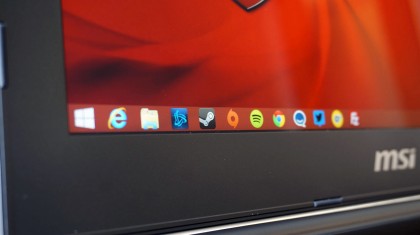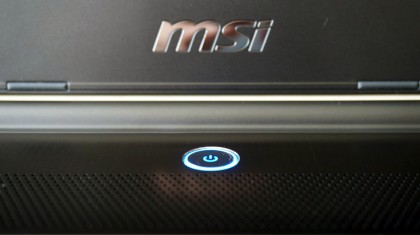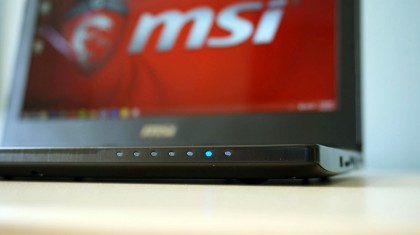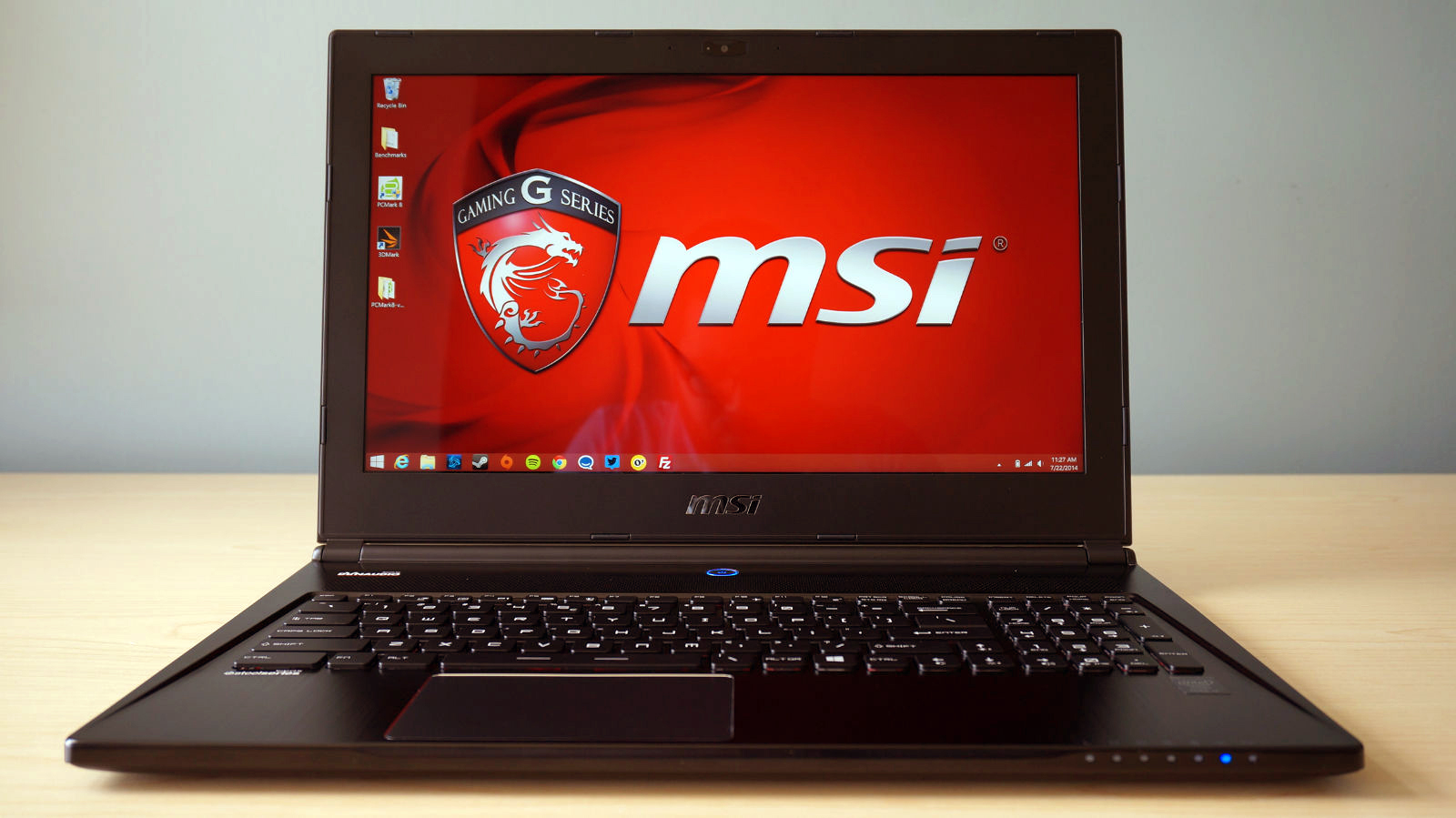Why you can trust TechRadar
Getting right to the point, it's worth wondering what kind of frame rates you can get out of a mobile gaming setup with such a sharp screen. More on that in a bit, but first, you're naturally going to do more on such a device than just play games. So, here's how MSI's latest performed on our suite of tests:
Benchmarks
- 3DMark: Ice Storm: 100,052; Cloud Gate: 16,865; Fire Strike: 4,334
- Cinebench CPU: 645 points; Graphics: 97.26 fps
- PCMark 8 Home: 2,885 points
- PCMark 8 Battery Life: 2 hours, 4 minutes
- Bioshock Infinite (1080p, Ultra): 53.54 fps; (1080p, Low): 168.45 fps
- Metro: Last Light (1080p, Ultra): 18 fps; (1080p, Low): 75 fps
For the sake of standardization, we test all gaming products on a 1920 x 1080 baseline for benchmarks. That said, the GS60 Ghost Pro 3K produced far better numbers than the Maingear Pulse 14, which scored a measly 41.58 and 11.01 fps on BioShock Infinite and Metro: Last Light at Ultra settings, respectively. (We've yet to test the Razer Blade, unfortunately.)

All around, the Ghost Pro 3K destroyed our benchmarks, though the Pulse 14 scored a slightly superior 2,957 on PCMark 8 and lasted 15 minutes longer on the battery test. What that means for general performance is a machine that will be able to handle multitudes of open programs at once, thanks to its quad-core CPU and gobs of RAM.
Gaming at 3K
The main draw of this Ghost Pro is its ability to play games at resolutions beyond mere "HD". But given that mobile GPUs still have a hard time pushing stable frame rates in the most demanding games at 1080p, how does that all shake out? Not all at that bad.
Playing World of Warcraft at native resolution and the sliders all pushed to the right is one thing. (One glorious, gorgeous thing at over 60 frames per second, might I add.) But ruining robots with rocket salvos at, say, Titanfall at WQHD+ resolution is another beast entirely.

That said, the Ghost Pro managed to produce a perfectly playable 36 fps in the brand new mecha-shooter at its native pixel count. However, that wasn't before bringing the texture detail down from "Ultra" at 1080p to "High", with v-sync at double buffered, 2x MSAA, about 30% draw distance and the rest of its settings notched at "High".
While it's not a terrible sacrifice to play one of the latest games at a post-HD resolution, you'll have a much easier time at standard 1080p. Plus, I expect the GTX 870M to only have a tougher time with later releases at 2,880 x 1,620, like Dragon Age: Inquisition and The Witcher 3.
Leave your lap out of it
MSI makes a big stink of its dual-fan thermal cooling design found inside the GS60 Ghost Pro. Easily mistaken for a speaker grill, the row of perforations on the notebook's keyboard deck are actually intake vents for two fans that work double time whenever the GPU or CPU are under heavy load.

Vents on either side of the unit are said to dissipate heat at a 45-degree angle to avoid contact with your hands. In practice, neither do much to keep the laptop cool while gaming. After just a few minutes of playing any game, the upper left side of the keyboard down to about the Escape key reaches painful temperatures.
The machine was so hot to the touch that, frankly, I was afraid to test how it felt on my lap for fear of my future reproductive health. While heat like this isn't terribly surprising from a gaming laptop this slim, and MSI successfully kept the area underneath the keyboard itself cool, it's worth a warning for sure.
Don't count on the battery
It's point that's getting tiresome to reiterate, but don't expect any sort of decent endurance from a 15.6-inch gaming laptop, period. Save for last year's more premium 14-inch Razer Blade lasting up to 6 hours in some cases, don't be surprised by gaming laptop times that barely reach over 2 hours.

Naturally, MSI's latest thin-and-light option is no exception, lasting just 2 hours and 58 minutes in my testing. That time was reported on the Balanced power setting with Bluetooth and the backlit keyboard disabled. The screen brightness was at 50%, while streaming high-bitrate music, running TweetDeck, HipChat and over 10 Google Chrome tas at a time with a USB mouse connected.
If you want to eke another 30 minutes or so, crank down the screen even further, but don't hold out for this thing to ever last for long untethered from its power cord. Given its light weight and thinness, however, I might expect a little more endurance to match the laptop's design.
Snappy SteelSeries, sucky SmartPad
MSI places a lot of focus on its partnership with PC peripheral maker SteelSeries for its keyboards, and rightfully so. The deal has been a boon for the company, producing some of the best gaming laptop keyboards that I've ever tapped on, and the Ghost Pro serves up no surprises there.

Beyond just the robust backlighting options and SteelSeries Engine software (more on that in a moment), the keyboard offers simply punchy returns on my presses and is well-spaced. The backlighting is bright and attractive, and the keys' matte surface prevented many a typo.
The ElanTech SmartPad-brand touchpad, however, was ultimately a disappointment. It may look spiffy – with its chrome trim and spacious, textured surface – but it's simply inferior to Synaptics. Multi-touch gestures, namely two-finger scrolling, were a pain to pull off with any regularity. While you're going to hook up a gaming mouse anyway, it's a sore-eye on an otherwise solid mobile gaming rig.
Bundled software
MSI doesn't stuff its gaming rigs with much in the way of free apps, otherwise known as bloatware, but it does offer some a few useful tools. Here are the most notable:
- Dragon Gaming Center: This hub allows you to track your PC's performance and easily access background processes to free up system resources.
- Killer Network Manager: Lets you allocate network adapter bandwidth to specific apps and games – ideal for online gaming and content streaming.
- SteelSeries Engine: Customize your keyboard's lighting and macro layout through this app, and share your set-ups with fellow users.
- XSplit Gamecaster: MSI offers 6 months free of this easy-to-use, resource-friendly live streaming service, with licenses starting at $14.95 (about £8.83, AU$15.94) for three months.

Joe Osborne is the Senior Technology Editor at Insider Inc. His role is to leads the technology coverage team for the Business Insider Shopping team, facilitating expert reviews, comprehensive buying guides, snap deals news and more. Previously, Joe was TechRadar's US computing editor, leading reviews of everything from gaming PCs to internal components and accessories. In his spare time, Joe is a renowned Dungeons and Dragons dungeon master – and arguably the nicest man in tech.

